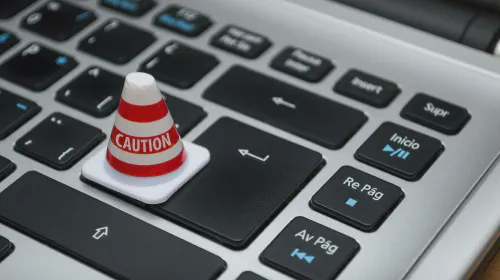Top 5 Blockchains for NFT Development - Choose the Best Blockchain for Minting NFTs
Salomon Kisters
Jun 28, 2022This post may contain affiliate links. If you use these links to buy something we may earn a commission. Thanks!
NFT, or non-fungible token is a blockchain-based technology that integrates any piece of digital data on a decentralized ledger and turns it into an immutable and non-interchangeable token.
The technology has been used widely by creators and artists to release their work in the form of digital assets in different marketplaces.
The NFT market caught fire in early 2021 year when Mike Wintlemann (commonly known as Beeple) sold his artwork NFT “Everydays - The First 5000 Days” for $69 million. Since then, the entire industry has been on an upward climb.
According to the NonFungible tracker, the total monthly sales reached the $4.5 billion mark in September last year.
Moreover, we have seen many projects, such as Bored Ape Yacht Club and Meebits, that captured sales ranging from a few hundred thousand dollars to a couple million.
Such massive expansion has led a lot of digital artists and creators to want to launch their own NFT projects. Nevertheless, users are often confused when it comes to choosing a blockchain for developing their NFT project.
In this article, you will learn how to choose a blockchain for NFT development and what blockchains are the best for NFT minting.
Factors to Consider
Following are some essential factors that you need to keep in mind whenever choosing a blockchain for NFT development.
Transaction Speed
Transaction speed is crucial for the success of any NFT project. Make sure the blockchain you plan to mint NFTs on can handle a large number of transactions at a time.
Otherwise, the inefficiency of the blockchain network will directly affect the performance of your project.
For instance, Litecoin processes only 50-60 transactions per second. If a creator launches an NFT project on a blockchain with these numbers, they will have to deal with delayed minting and transfers.
On top of that, these delays will get even longer during the high-traffic hours.
Transaction Cost
Not every NFT is going to be a hit. In fact, most of the NFTs are relatively cheap. If an artwork is not going to surpass the few hundred dollars mark, why pay a massive fee and lose a substantial portion of your profit?
The average transaction cost, more or less, depends on the transaction speed of the blockchain. It is the fees users have to pay to the blockchain to complete their transactions.
When the network is busy, you may have to pay higher fees to outbid other users and ensure that validators prioritize your order. Otherwise, it may get rejected.
Security
The security of a blockchain network is another critical aspect. Contrary to common belief, a blockchain can get hacked if it is not fundamentally strong enough.
In such cases, all sorts of users, including investors, traders, and NFT creators, end up losing their funds and data. The recent $600 million Ronin hack is one infamous example that highlights the necessity of using secure blockchains.
Smart Contracts
All NFTs on every blockchain rely on smart contracts. They are used to set up terms and conditions for transactions on a blockchain. When these terms are met, the transfer is automated and processed without the need for a third-party validator.
Blockchains with well-programmed and sophisticated smart contracts tend to be more secure and functional for users and NFT developments.
Moreover, the programming language used to develop these smart contracts should not be uncommon. Otherwise, you may face difficulty finding an expert developer.
Consensus Mechanism
The type of consensus model a blockchain uses is probably the most important factor all NFT creators need to consider. Apart from determining other significant aspects, such as fees, speed, functionality, and security, a consensus model also impacts the environment.
Blockchains with the Proof of Work consensus model involve high electricity consumption and the use of powerful computing devices to approve a transaction.
As a result, developing NFTs on these blockchains can lead to the emission of greenhouse gasses.
That’s why it is recommended to adopt only those blockchain ecosystems that use Proof of Stake or other greener consensus models.
The Best Blockchain to Develop NFTs
Ethereum
Launched in 2015 by Vitalik Buterin, Ethereum was the first blockchain to introduce smart contracts – the technology that made non-fungible tokens possible. Ever since then, the blockchain has gone through multiple developmental phases to facilitate and promote the progress of NFTs.
Today, Ethereum is home to more than 80,300 NFT collections. From the pioneering projects of the industry (CryptoPunks and CryptoKitties) to many of the current hits (MeeBits and Bored Ape Yacht Club), most of these projects are powered by ERC-721 and ERC-1155 token standards.
ERC-721 allows developers to mint non-fungible tokens, while ERC-1155 enables the creation of semi-fungible tokens. Apart from these two, the Ethereum development team recently proposed a new token standard, EIB-2309, to enable the minting of multiple NFTs in a single transaction.
Moreover, almost all prominent NFT marketplaces constitute most of the industry’s trading volume, including OpenSea, Rarible, Nifty Gateway, SuperRare, Decentraland, and KnownOrigin, which are developed on the Ethereum network.
As far as the network mechanism is concerned, Ethereum shifted from the PoW (Proof of Work) model to the PoS (Proof of Stake) model during London Hard Fork, increasing the blockchain’s functionality and scalability.
Compared to the older model, which could handle only 15-25 transactions per second, the newer PoS Ethereum blockchain is capable of handling 100,000 transactions at the same time.
Flow
Flow is one of the most popular alternatives to the Ethereum blockchain.
Developed by the Dapper Labs in 2019 – the team behind the development of CryptoKitties – Flow is primarily focused on sustainability, scalability, composability, and user experience.
Despite being a new ecosystem, Flow has already established its name in the industry, producing several opportunities for NFTs, blockchain-based games, and dApps (decentralized application) developers. The network is based solely on the PoS consensus model, enabling it to execute about 10,000 transactions every minute.
As of now, more than 100k transactions are processed daily. Moreover, the blockchain has successfully hosted more than 3 million transactions since its beta testing phase in October 2020.
Flow has dominated the market specifically in the sports NFTs sector, facilitating NBA’s Top Shot, NFL’s All Day, UFC’s Strike, and many more successful projects. BlocktoBay and Xtingles are two of the most popular NFT marketplaces created on the Flow blockchain.
Solana
Solana is famous as one of the fastest blockchains and a competitor to the Ethereum ecosystem. The hybrid PoS and PoH (Proof of History) consensus model allow the blockchain to execute 65,000 transactions per second at a very minute cost.
Founded by Anatoly Yakovenko, Solana is one of the top contributors to NFT, DeFi, and Web 3.0 space. It currently hosts 350+ projects on its ecosystem and plans to add 1,000 more in the following year.
Some notable NFT collections on the blockchain include Degenerate Ape Academy, Solana Monkey Business, SolPunks, Frakt, Bold Badgers, and Sollamas. You can trade these NFTs on Solana-based NFT marketplaces, such as Solsea and Solanart.
This ecosystem caught the spotlight in early 2021, resulting in its native token, SOL, surging a whopping 10,000% in price.
Cardano
Created by one of Ethereum’s co-founders Charles Hoskinson, Cardano is one of the most popular blockchain ecosystems in the industry. Currently, it is the seventh-largest blockchain in the world, with a market capitalization of $16.6 billion.
Cardano is based on the distributed PoS consensus mechanism and focuses on creating a robust ecosystem for developing decentralized applications and NFTs.
The blockchain has two layers: Cardano Settlement Layer (CSL) and Cardano Computation Layer (CCL). CSL accommodates the transaction of ADA (Cardano’s native token) and recording transactions, while CCL is responsible for hosting smart contracts.
Although Cardano currently processes around 250 transactions every minute, you must not underestimate this high-performance blockchain based on this statistic alone.
According to Hydra – Cardano’s Layer 2 scaling protocol – the blockchain can potentially reach a transaction speed of up to 2 million TPS.
As far as NFT projects running on Cardano are concerned, Spacebudz, CardanoKidz, Professor Cardano, CryptoMayor, and Crypto Knitties have been widely successful.
Binance Smart Chain (BSC)
Binance Smart Chain is a unique blockchain that is based on the Binance Chain. However, it is neither a Layer 2 scalability protocol nor an off-chain solution and will continue to function even if the Binance Chain goes down.
The crypto-token BNB is used for transaction fees on both blockchains and runs smart contracts on BSC.
BSC is a centralized blockchain that uses the PoSA (Proof of Staked Authority) consensus model to approve and record transactions. This mechanism enables it to execute about 160 transactions per second at a very cheap cost.
The blockchain has its own token standard, BEP-721, to facilitate the development of NFTs. Moreover, it is also compatible with Ethereum Virtual Machine, enabling support for a wide range of Ethereum-based applications as well.
Final thoughts
Despite the ongoing craze (and recent downturn as of 2022), NFT technology is still in its early stages.
We will gradually start to see its implications in different industries as it grows over time. And those who get into it early on will benefit the most from the future expansion of NFTs.
However, picking a suitable blockchain is critically important. You must ensure that the blockchain you chose to develop your NFT project is fundamentally strong enough to sustain and evolve throughout the changing industry tren
Stay informed with the latest insights in Crypto, Blockchain, and Cyber-Security! Subscribe to our newsletter now to receive exclusive updates, expert analyses, and current developments directly to your inbox. Don't miss the opportunity to expand your knowledge and stay up-to-date.
Love what you're reading? Subscribe for top stories in Crypto, Blockchain, and Cyber-Security. Stay informed with exclusive updates.
Please note that the Content may have been generated with the Help of AI. The editorial content of OriginStamp AG does not constitute a recommendation for investment or purchase advice. In principle, an investment can also lead to a total loss. Therefore, please seek advice before making an investment decision.

8 Ways Blockchain Supports Sustainability
While the benefits of blockchain are plentiful, the question is, how does it support sustainability?

How Blockchain Supports Data Privacy
In this article, we will discover how blockchain technology supports data privacy and integrity in different ways.

Blockchain Security Audit: Definition, Process, and Importance
A blockchain security audit is a secure technology that supports high-value transactions taking place on a blockchain. The process involves sophisticated code analysis to identify and eliminate vulnerabilities in applications.
Protect your documents
Your gateway to unforgeable data. Imprint the authenticity of your information with our blockchain timestamp